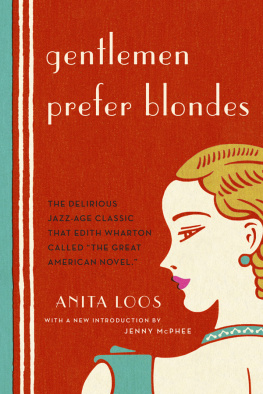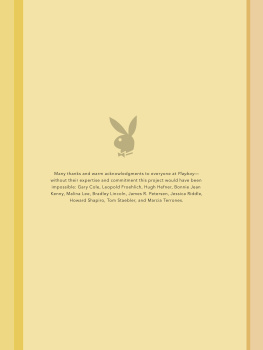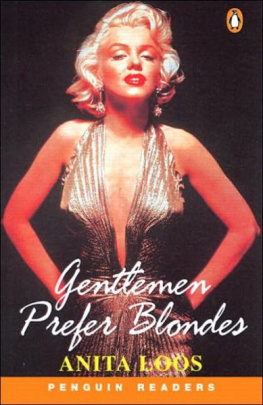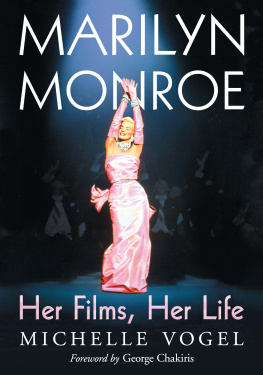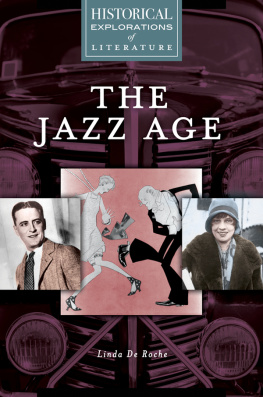

A NITA L OOS was born in 1889 in California. She began writing movie scripts at the age of twelve, and had sold four by the time she was twenty-four. Before her death in 1981, she had written an enormous number of stories, screenplays, articles, plays, and more, but it was with the original publication of Gentlemen Prefer Blondes , in 1925, that she became an international celebrity.

Kissing your hand may make you feel very good but a diamond bracelet lasts forever .

Introduction by Jenny McPhee to the Liveright
paperback edition copyright 2014 by Jenny McPhee
Copyright renewed 1991 by Jay S. Harris
Copyright 1963 by Anita Loos
Copyright renewed 1952 by Anita Loos Emerson
Copyright 1925 by Anita Loos
Copyright 1925 by The International Magazine Co, Inc. ( Harpers Bazaar )
Reissued as a Liveright paperback 1998, 2014
All rights reserved
For information about permission to reproduce selections from this book,
write to Permissions, Liveright Publishing Corporation,
a division of W. W. Norton & Company, Inc.,
500 Fifth Avenue, New York, NY 10110
For information about special discounts for bulk purchases, please contact
W. W. Norton Special Sales at specialsales@wwnorton.com or 800-233-4830
Book design by Barbara Bachman
Production manager: Louise Parasmo
ISBN 978-0-87140-317-9 (pbk.)
ISBN 978-1-63149-302-7 (e-book)
Liveright Publishing Corporation
500 Fifth Avenue, New York, N.Y. 10110
www.wwnorton.com
W. W. Norton & Company Ltd.
Castle House, 75/76 Wells Street, London W1T 3QT
Contents

BY J ENNY M C P HEE
BY A NITA L OOS
To
John Emerson
I FIRST SAW THE MOVIE G ENTLEMAN P REFER B LONDES when I was about thirteen. It was the seventies, my parents had recently divorced, and I had moved with my mother and three sisters from suburbia to live with my new stepfather and his five kids on a pseudo-commune in rural New Jersey. The governing philosophy of The Farm, as we called it, was challenging authority. Hierarchy, patriarchy, capitalism, government, police, school, anything remotely conventional was disputed, derided, and upended. One sister had a poster of Gloria Steinem in her room; another, Angela Davis; and a stepbrother, a huge red flag with Che Guevaras picture on it. I covered an entire wall of my room in images of Marilyn Monroe.
I had become obsessed with Marilyn, not only as a sublime comedienne but also as an icon of social, political, and sexual subversion. I watched her films incessantly, revelling in what I perceived to be their subliminal insurgent message. In most of her roles, but especially as Lorelei Lee, Marilyn seemed to have ascertained that the world was one big bastion of hypocrisy, especially when it came to women, so she put a new spin on an old adage: if you cant beat em, make em pay, pay, pay. She conformed exquisitely to patriarchal expectations of her, honed her seductive powers and female wiles, cultivated her beauty and charm, prettified her razor-sharp wit, and, while never compromising her Leibnizian belief that beneath all the crap and rot humanity could shovel up this was, after all, the best of all possible worlds, she hung everybody out to dry.
I can only imagine how I might have been further inspired if, at the time, I had read Anita Looss novel Gentleman Prefer Blondes , which was first published in 1925 at the height of the Jazz Age. The original Lorelei Lee goes leagues beyond Howard Hawkss renditionand would have made a delightful compatriot at The Farm. In her inimitable first-person narrative in diary form, Lorelei skewers every possible power structure: politics, religion, class, society, culture, consumerism, psychoanalysis, Hollywood, even language itself. Sadly, as predictably happens with works authored by women, Looss once massively best-selling book was dismissed and, by the 1970s, forgotten. And though I appreciated Holden Caulfields rants against phoniness, he didnt have a clue what a girl was up against. Happily, over the last decade, feminist literary scholars have done much to recover Looss work and this fine new edition of Blondes , brought out by the novels original publisher, goes far in awarding it deserved eminence in our collective cultural history.
In Looss prefatory essay The Biography of a Book, she claims that Gentlemen Prefer Blondes was begun as a brief sketch on a train in response to the inordinate attention that a blonde sitting nearby was given by fellow male travellers while she was all but ignored. Knowing that her pal H. L. Mencken had a similar weakness for peroxide, she sent him the story, which he admired but declined to print in the American Mercury . Little girl, he wrote to Loos, youre making fun of sex and thats never been done before in the U.S.A. I suggest you send it to Harpers Bazar , where itll be lost among the ads and wont offend anybody. Henry Sell, editor of what was then called Harpers Bazar: A Repository of Fashion, Pleasure and Instruction , was eager to publish Looss story and, wanting to serialize it, insisted she continue the chronicle of Loreleis quest to improve her mind and her ambision to reform her friend and foil Dorothy as they travel to London, Paris (The Eyefull tower is devine), Vienna, Budapest, and back home to New York.
Loreleis, and by extension Dorothys, education is funded by daddy-in-chief Gus Eisman, king of the button business. Lorelei, too savvy to rely on just one income source, supplements her stock by procuring jewelry from various admirers along the way. Though she much appreciates European gallantry, in the end American values prevail: I mean a girl has to look out in Paris, or she would have such a good time in Paris that she would not get anywheres. So I really think that American gentlemen are the best after all, because kissing your hand may make you feel very very good but a diamond and safire bracelet lasts forever.
The book in its entirety was published by Boni & Liveright, renowned for their modernist authors. In that same year, 1925, they published works by Dreiser, Hemingway, Faulkner, Eliot, and Pound. The first printing, a modest 1,200 copies, was followed within two weeks by a second of 20,000, succeeded by many more reprints. Over the next quarter century the book would continue to sell well and was adapted into a play, a silent film (now lost), a musical, a comic strip, a dress fabric, and a wallpaper. The 1953 release of the screen version starring Marilyn Monroe and Jane Russell eclipsed the book thereafter.
Loos began her career writing scenarios for silent films. Born in 1889 in Sisson, California (today Mount Shasta), Corinne Anita Loos had a strict mother and a philandering father. A newspaper editor with wanderlust, her father moved the family around California towns, opening and shutting local publications a few times a year, but his true ambition was to become involved in theater production. To that end, he landed Anita, age six, a part in a stock companys stage version of Quo Vadis? That same year, she won a limerick contest in a childrens magazine and her desire to write was ignited. She continued her acting career until she graduated from high school, when, realizing she preferred the pen to the spotlight, she set out to become a writer. Eventually she got herself a job writing for Biograph, a film production and exhibition company. Loos wrote hundreds of scenarios and intertitles during the silent film era, ultimately becoming one of Hollywoods preeminent screenwriters. She wrote scripts for stars such as Douglas Fairbanks ( His Picture in the Papers , 1916), Jean Harlow ( Red-Headed Woman , 1932) and Clark Gable ( San Francisco , 1936), and was asked by Clare Booth Luce to adapt The Women (1939).
Next page
